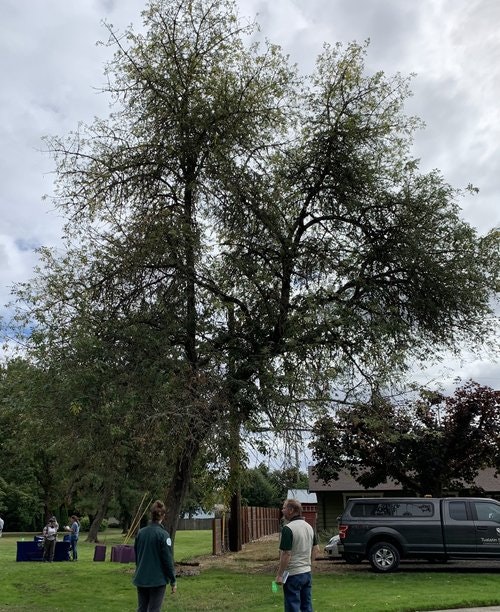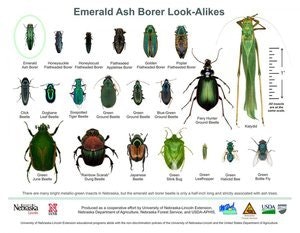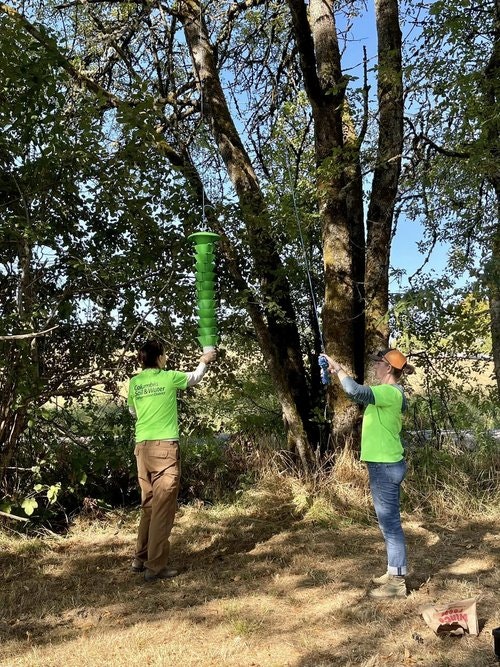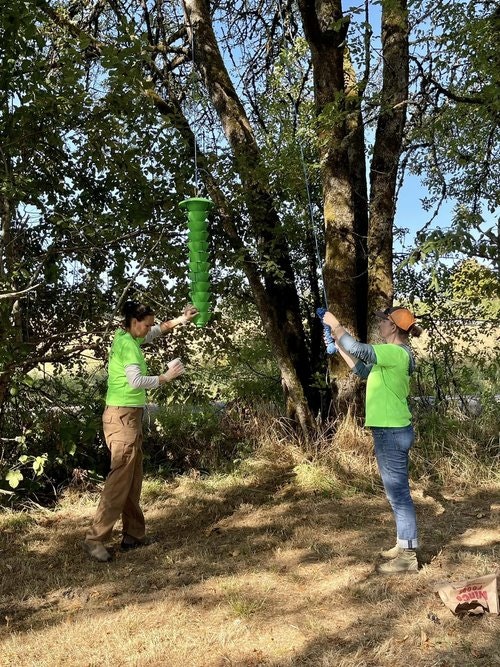Emerald Ash Borer Monitoring
Conservationists with the Columbia Soil and Water Conservation District have been participating in early detection trapping and monitoring for the presence of the Emerald Ash Borer in Columbia County since 2019. We became aware of the beetle as a threat to our native ash trees after it was identified in Michigan in 2002. As of June 2022, the beetle has infested trees in 36 states and is often only found after infesting a tree for a number of years. It is important to identify them early in order to stop or contain the spread of this beetle which has already killed over 100 million ash trees within the United States.
Emerald Ash Borer (EAB), Agrilus planipennis Fairmaire, was detected in Forest Grove, Oregon on June 30, 2022. It is very likely we will see the insects at some point in the future, but knowing as soon as it arrives will hopefully give us the ability to deal with it before it has the chance to become widespread. EAB is only interested in ash trees and prefers our native Oregon ash, which is an important member of wetland habitats. Losing them will lead to a loss of shade, changes in water quality, and increased stress on some of our threatened and endangered species of wildlife. The beetles are attracted to distressed ash tree first, but will also infest healthy trees. High risk areas have been identified in Columbia County especially along the Columbia River.
The traps we monitor attract adult beetles that are only active between mid-May through mid-August. Adults are slim metallic green beetles that are approximately half an inch long. They chew on leaves in the canopy and are rarely noticed below, but females are busy feeding and laying eggs in the crevices of bark. Within a couple of weeks the eggs hatch and the larva chew their way into the bark where they do the real damage by tunneling under the bark, consuming the phloem, cambium, and outer xylem. As larva feed and mature they create serpentine tunnels that damage the vascular system of the tree, causing trees to wilt and die back. They spend winter under the bark in small chambers. Early in the spring they pupate for a couple of weeks before maturing into a new generation of adults, When they are ready to enter the world as adults they chew ‘D’ shaped holes and emerge to start the cycle again. Depending on the health of the tree, the beetles may take one or two years to complete their life cycle.
CSWCD began monitoring in 2019. You may see funnel traps or large purple sticky traps hanging in ash tree canopies. To date our traps have been empty of Emerald Ash Borers, but we have noticed many familiar common pests such as paper wasps and yellow jackets, especially on the banks of the Columbia River. In 2021 we did see one green bark beetle, too small and darker than EAB, that did cause us a little distress until we identified it and were able to put our concerns to rest.
Part of our monitoring process is to watch for trees showing signs of stress. You can help. Watch for wilting ash trees where the crown or top third of the tree is dying. Especially notice if they are sprouting new growth near the base of the tree. You may also notice that woodpeckers have been attracted to the tree and have scraped the bark to expose feeding larva. If this is the case, you may be able to see the signature ‘S’ curves of the burrowing larvae. It is also possible to see the small D-shaped emergence holes on the trunk of a tree. Round holes generally indicate woodpecker activity and are generally nothing to worry about. If you do suspect a tree is suffering from EAB damage, report it to the Oregon Invasives Hotline at 1-866-Invader, or by following the link below.



.png?ixlib=rb-1.1.0&w=2000&h=2000&fit=max&or=0&s=fa388406d4166448691737713768fe64)
.png?ixlib=rb-1.1.0&w=2000&h=2000&fit=max&or=0&s=335fe9914ee1e8815e99b5cf4063b935)








.png?ixlib=rb-1.1.0&w=2000&h=2000&fit=max&or=0&s=fa388406d4166448691737713768fe64)
.png?ixlib=rb-1.1.0&w=2000&h=2000&fit=max&or=0&s=335fe9914ee1e8815e99b5cf4063b935)





ADDITIONAL INFORMATION AND RESOURCES
We are looking for volunteers to monitor Ash tree health around Columbia County by locating and uploading observations to iNaturalist. Learn how to recognize ash trees here.
Oregon Invasive Species Council Online Hotline for reporting EAB: https://oregoninvasiveshotline.org/
Oregon Department of Forestry Forest Facts: Emerald Ash Borer (EAB): https://www.oregon.gov/odf/Documents/forestbenefits/fact-sheet-emerald-ash-borer.pdf
Learn more about EAB and Oregon’s first sighting in the Oregon Department of Agriculture’s news release.
More information and resources can be found here.
